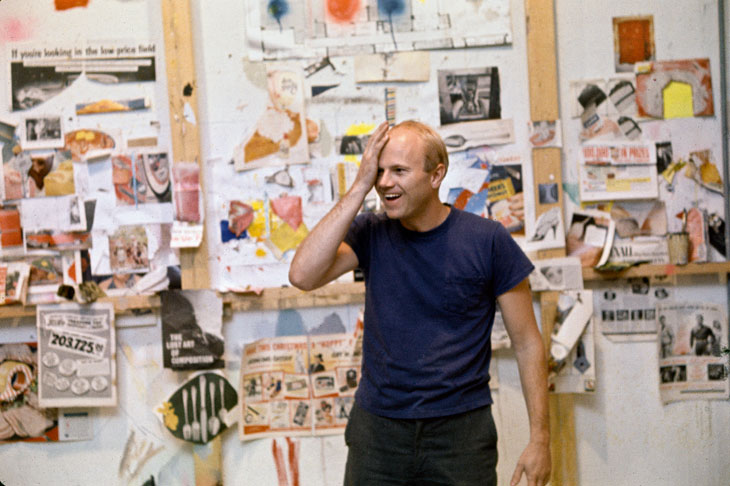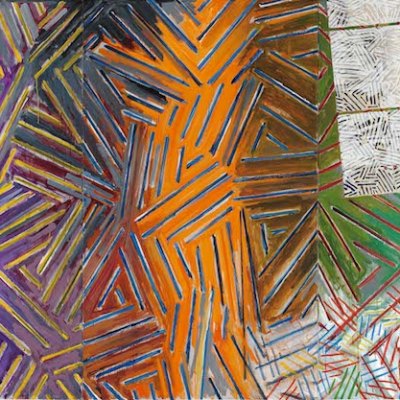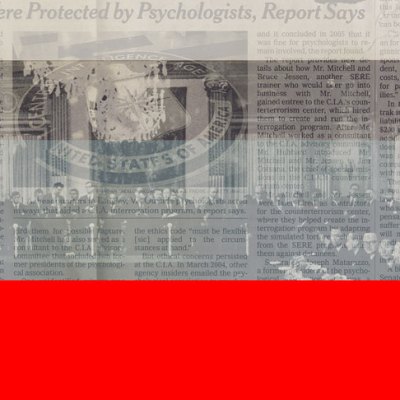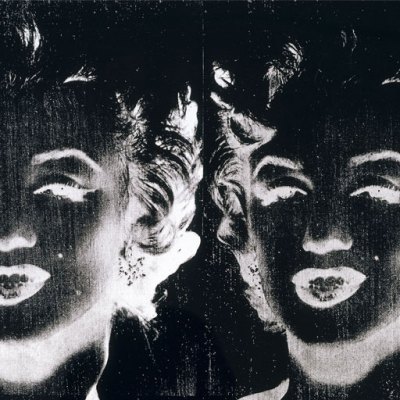After studying at the Minneapolis School of Art and the Arts Students League in New York, where he was a contemporary of Jasper Johns and Robert Rauschenberg, James Rosenquist found paid work as a painter of billboard signs in Times Square. His skill in taking small black-and-white images and ‘scaling-up’ on to large spaces for the billboards soon informed his art, as he began to combine this process with techniques that juxtaposed visual material, drawn from contemporary advertisements, in paint. Rosenquist later explained of this approach to painting: ‘It was simply the idea of doing something that had the same force as advertising, using their techniques and bizarre imagery.’
This signature method is demonstrated in what is perhaps Rosenquist’s most celebrated painting, President Elect, (1960–61/1964), the centrepiece of the retrospective currently at the Museum Ludwig in Cologne, the first major show mounted since the artist’s death last year. The painting blurs a campaign portrait of John F. Kennedy with an ad for Swan’s Down Devil’s Food mix, as it appeared in Life magazine. A thumb protrudes from Kennedy’s eye; a proffered hand with a slice of cake from his chin. The rear-wheels of a slick car float in the background on the right-hand side. The familiar, carefully constructed image of the smiling, white-toothed president-to-be, optimism and youth personified, is transformed into something rather different and peculiar.
President Elect (1960–61/1964), James Rosenquist. Centre Georges Pompidou, Musée National d’Art Moderne/Centre de Création Industrielle, Paris. Photo: courtesy of the Estate of James Rosenquist; © Estate of James Rosenquist/VG Bild-Kunst, Bonn, 2017
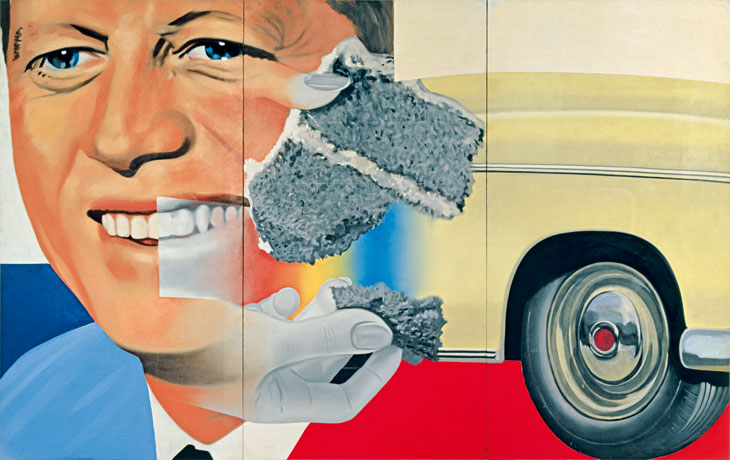
Entitled ‘Eintauchen ins Bild’ (Painting as Immersion), the exhibition supplements the museum’s considerable collection of works by Rosenquist with big-name loans like President Elect, as well as the 86-feet-long F-111, together with source material and preliminary sketches. (Rosenquist, who had a long association with the Ludwig, was involved with the initial planning stages.) The curators have meticulously researched the primary sources for these paintings, most of which were copied from advertisements for things like toothpaste, war bonds, or washing machines from some 1,500 issues of Life magazine. We might wonder whether it is worthwhile or even interesting to track down the original sources for each painting. However, in Rosenquist’s case, it does feel important, even essential to the subtle process through which he transplanted advertising imagery into the world of politics, celebrity, and industry. ‘I tell history in terms of fragments,’ Rosenquist once wrote, ‘the fragments butt up against each other, and the story gets told from the friction they create. I wanted to bombard the viewer with implausible juxtapositions’.
Source material and first study for Zone (1960). Estate of James Rosenquist. Photo: courtesy of the Estate of James Rosenquist; © Estate of James Rosenquist/VG Bild-Kunst, Bonn, 2017
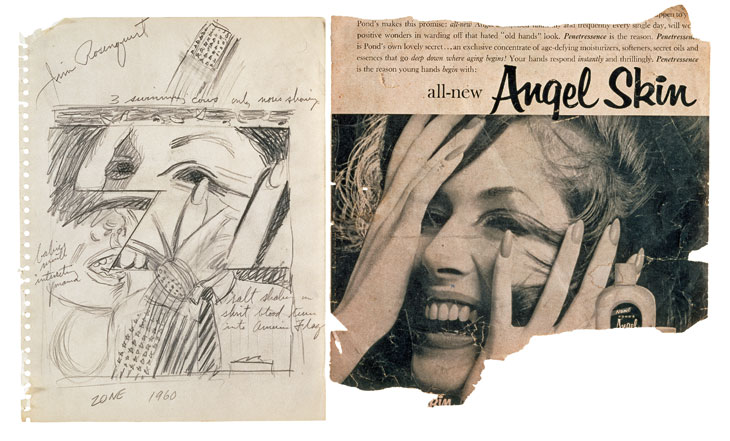
It’s clear why Rosenquist was such a trailblazer in the development of what would become Pop: for Zone (1960–61), he lifted a fragment from a Campbell’s soup advertisement at least a year before Warhol did the same thing more ostentatiously. But Rosenquist’s fragments, and the emotive and sensorial effects they generate when coalesced, are not merely taken from popular culture and the detritus of marketing slogans for household products. In one preliminary study for Zone, alongside an Angel Skin ad depicting a woman placing her hands over her face, lost in cosmetic rapture, Rosenquist copies out the image sketched with Cubist lines, perspective and proportions. In the woman’s dramatically contorted features, a resemblance to Picasso’s Weeping Woman emerges. If advertising wants to make us feel many things, from jealousy and desire to community and belonging, it is rarely designed to make us feel pity. Rosenquist, by looking at the ad through the lens of Picasso’s portrait of the Spanish Civil War, surreally complicates the range of affective signals generated by this promotional portrait.
The link to Picasso and his depictions of suffering appears also in Rosenquist’s later work, as in the monumental trilogy The Swimmer in the Econo-mist (1997–98): an integration of the tortured horses of Guernica into a perverse post-Cold War tapestry in which, for Rosenquist, ‘war and industry continue their old pact.’ It makes sense that Rosenquist, a life-long peace activist and contributor to the artists’ Tower of Protest against the Vietnam War in 1966, chose to incorporate parts of Picasso’s famous anti-war painting into his schema. But the nod to Guernica does not just gesture to Rosenquist’s pacifist credentials. In The Swimmer, a Kellogg’s logo melts into slinky rings and a F-111 fighter jet, a recurring motif in Rosenquist’s work, is armed with red lipstick. The links between consumerism and the politics of intercontinental warfare emerge as the subject of the work: ‘Do wars support the military-industrial complex and therefore support the people?’ the artist once asked.
The Swimmer in the Econo-mist (Painting 3) (1997–98), James Rosenquist. Solomon R. Guggenheim Museum, New York. Photo: courtesy of the Estate of James Rosenquist; © Estate of James Rosenquist/VG Bild-Kunst, Bonn, 2017
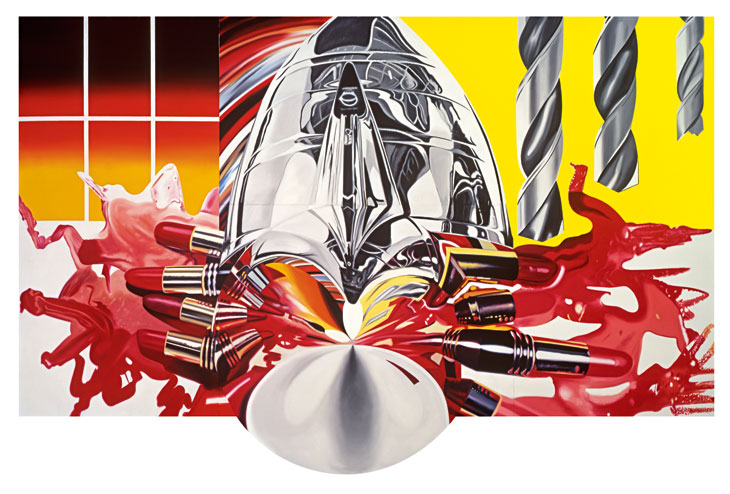
Rosenquist composed The Swimmer by looking at a catalogue of photographs through a tube with a mirrored interior, the images viewed through this makeshift instrument contorted beyond stable recognition. This approach demonstrates Rosenquist’s privileging of distorted or peripheral vision, of the shapes and visual phenomena recognised but not focused upon, both as a mode of seeing and as an approach to artistic production. He believed that many of the great artists of the past had harnessed the perspectives of peripheral vision in their practice, from Monet, known to stand in the centre of his paintings, assembled into a circle to Jackson Pollock, who famously stalked around, about and over his canvases. Rosenquist directly refers to the former in the aptly-titled The Meteor Hits Monet’s Garden from the late 1990s. This work, in the exhibition’s final room, parodies Monet’s Impressionist style and playfully depicts a phallic meteor about to crash into his garden at Giverny. It completes an impressive record of a long, wide-ranging career that reveals several surprising art-historical genealogies.
‘James Rosenquist: Painting as Immersion’ is at Museum Ludwig, Cologne, until 4 March 2018.
